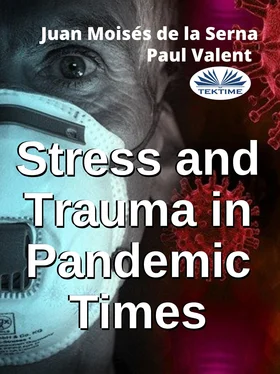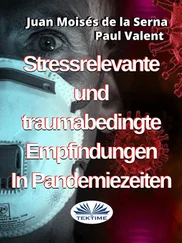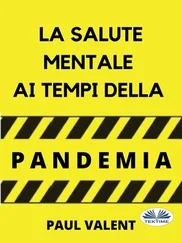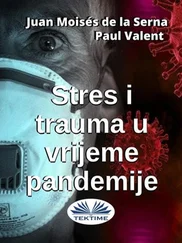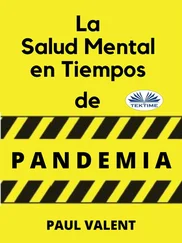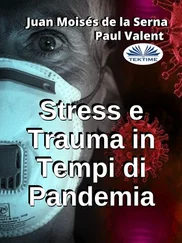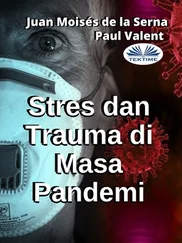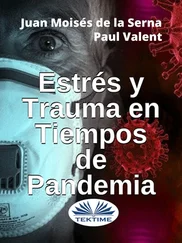Stress and Trauma
In Pandemic Times
Paul Valent
Juan Moisés de la Serna
Editorial Tektime
2021
“Stress and Trauma in Pandemic Times”
Writed by Paul Valent & Juan Moisés de la Serna
1st edition: January 2021
© Juan Moisés de la Serna, 2021
© Tektime Editions, 2021
All rights reserved
Distributed by Tektime
https://www.traduzionelibri.it
The total or partial reproduction of this book, nor its incorporation into a computer system, nor its transmission in any form or by any means, be it electronic, mechanical, by photocopy, by recording or other means, is not allowed, without prior permission and in writing from the editor. The infringement of the aforementioned rights may constitute a crime against intellectual property (Art. 270 and following of the Penal Code).
Contact CEDRO (Spanish Center for Reprographic Rights) if you need to photocopy or scan any fragment of this work. You can contact CEDRO through the web www.conlicencia.com or by phone at: 91-702-19-70 /93 272 04 47.
About the authors:
Paul Valent
Paul Valent was born in Bratislava, Slovakia in 1938. He and his parents survived the Holocaust in Hungary. In 1949 the family emigrated to Australia.
Valent completed his medical studies in 1962, and his psychiatric studies in London in 1967. Back in Australia from 1970 Valent worked in emergency departments of major hospitals and in private practice until 2002.
He developed special interests in psychosomatic medicine, and stress and trauma. He founded and was later president of the Australasian Society for Traumatic Stress Studies and founded and was president of the Child Survivors of the Holocaust group in Melbourne .
Valent has written numerous books, papers, and chapters related to psychotherapy and trauma (www.paulvalent.com). His latest work was Mental Health in the Times of the Pandemic , a precursor to this book.
Juan Moisés de la Serna
Juan Moisés de la Serna has a PhD in Psychology and a Master of Neuroscience and Behavioral Biology. Online Adjunct Faculty.
Nowadays, his research focuses on Potential Factors Influencing COVID-19, and Short- & Long-Term Psychological and Neurological complications after SARS-CoV-2 infection in humans.
In the base of researchgate.net, he was the most read author in Spain in 2020.
Spanish Popular Science Writer, de la Serna has published more than thirty books on Psychology and Neuroscience Topics including AD; PD; ASD; ADHD; EQ; MSD; HiQ.
In 2020 he wrote Psychological Aspects in time of Pandemic and A Psychological Perspective of the Health Personnel in Times of Pandemic .
Prologue
People frequently say that the COVID-19 pandemic is unprecedented. Yet from a bird’s eye point of view it has similarities with other pandemics, even other illnesses, and with other stresses and traumas. In fact, each situation of stress and trauma illuminates all the others.
We are on the cusp of a science of stress and trauma. In this book we indicate how the current pandemic interweaves with that science, both benefiting and contributing to it. In other words, though in this pandemic each person and community feel that their sufferings are unique, in fact they overlap with other areas of suffering that can provide benefit to our collective wisdom.
In this book two scientists from different parts of the world have come together to meld their knowledge of stress and trauma and apply it, together with their current observations, to understanding of the pandemic.
Reciprocally, because all traumatic situations overlap, lessons from the pandemic will benefit other situations of stress and trauma. Thus the contents of this book are relevant to every traumatic situation.
The book is laid out in the following. Chapter 1 considers previous traumatic situations, while chapter 2 compares them with the pandemic. Chapter 3 introduces stress and trauma terms and applies them to the pandemic. Chapters 4-6 explore the range of stress and trauma processes and consequences all the way from cellular to international levels. Chapter 7 explores the dialectic between death and resilience, while chapter 8 summarises the previous chapters. Finally, chapter 9 applies stress and trauma understanding to amelioration and treatment of COVID-19 consequences.
Dedicated to all victims of THE COVID-19 pandemic.
Chapter I. Different stress and trauma situations - disasters, wars, Holocaust, etc.
Chapter II. The current Global Health Crisis: is the pandemic a global stress and trauma situation?
Chapter III. The Language of Stress and Trauma; Its Application to the Pandemic.
Chapter IV. Starting to Make Sense of the Pandemic’s Consequences
Chapter V. Processes that Make Sense of the Pandemic’s Consequences.
Chapter VI. Pandemic Consequences: From Cells to International Politics
Chapter VII. Death and Resilience.
Chapter VIII. General Understanding of Pandemic Stresses and Traumas. Summary.
Chapter IX. Amelioration and Treatment of COVID-19 Consequences
Chapter I. Different stress and trauma situations - disasters, wars, Holocaust, etc.
Paul Valent
The COVID-19 pandemic reared its head at the beginning of 2020. Well, we thought initially, another corona virus, no worse than other colds and influenzas, so we hoped and denied. Until it engulfed us, and then we were counting the numbers of infected and dead.
We were unfamiliar with pandemics. How were people to think about it? Was the pandemic like a natural disaster? Or was it an illness like others, where some died others escaped or were left bereaved? Was it like an infiltration by an invisible enemy? Or was the pandemic like a biblical pestilence, along with more frequent fires, storms, and floods, punishing a greedy world?
It was natural to try to conceptualise this unfamiliar danger according to what we already knew. It was also natural to fill in lack of scientific data with magical thoughts.
In this chapter we will look at other circumstances with widespread threats to life and see how their features overlap with and elucidate the current crisis.
Traffic deaths
About 40,000 people die of traffic incidents in the US annually, and 1.25 million die around the world. In addition, 50,000,000 are seriously injured worldwide. In a sense traffic deaths are a low grade chronic pandemic.
Traffic deaths are a prime example of avoidance and denigration of psychological aspects of catastrophes. Historically, complaining survivors were accused of compensation neurosis, while psychological factors among those causing accidents were almost totally ignored.
In fact, close examination of both victims and perpetrators reveals a wide variety of physical, psychological, and social dysfunctions (Valent, 2007).
Natural Disasters
Natural disasters such as fires, floods, and earthquakes are usually short-term circumscribed events that do not threaten the rest of the population. Help pours in quickly from outside to help the victims.
Disasters have arguably been the most scientifically studied mass traumatic situations. They revealed that traumatic events manifest different phases : pre-impact, impact, post-impact, recovery and reconstruction. Disaster responses have also been noted to ripple to secondary victims such as helpers and children, and can ripple even across generations .
Generally, mortality and morbidity from all kinds of illnesses increase in proportion to severity and duration of specific stresses and traumas. The nature of what survivors, secondary victims, and communities experience varies very widely across physical, psychological, and social scenarios.
Читать дальше
